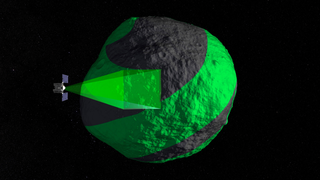Arrival at Bennu

OSIRIS-REx arrived at Bennu for a close encounter of the asteroid kind.
The asteroid Bennu is one of 780,000 asteroids in our solar system. Out of all those, it was chosen as the destination for NASA's Origins, Spectra Interpretation, Resource Identification, Security, Regolith Explorer (OSIRIS-REx) spacecraft on a mission to understand our early solar system and return a sample from the asteroid's surface to Earth. After a two-year journey, OSIRIS-REx arrived at Bennu in December 2018 to begin its science mission. But what made Bennu a good source for answers? First, Bennu’s proximity to Earth meant a quicker and easier flight for OSIRIS-REx. The spacecraft used Earth’s gravity to boost itself toward the asteroid. Bennu’s size is another bonus: it allows Bennu to spin on its axis at a rate that makes it easily approachable by a spacecraft, and rich in soil that would’ve flung off of smaller, fast-spinning asteroids. Its ancient age and the fact that it is well-preserved in the vacuum of space means it contains dust from the formation of our solar system. Bennu also is rich in carbon, which could offer clues to the possible role asteroids played in life on Earth. Plus, scientists have studied Bennu from Earth, and now will see whether their predictions about it were right. This will help us understand other asteroids, particularly their trajectory, and help us deflect ones that come too close. Watch the videos to learn more.
Explore why scientists are excited to study our solar system's early years at Bennu.
Learn how scientists narrowed down the asteroid candidates for the OSIRIS-REx mission.

One of the first mosaic images of Bennu put together from twelve images taken just 15 miles (24 km) away by OSIRIS-REx on Dec. 2, 2018.

OSIRIS-REx will orbit Bennu for the first two years of its mission, taking detailed observations of its surface.
For More Information
Credits
Please give credit for this item to:
NASA's Scientific Visualization Studio
-
Animators
- Walt Feimer (KBR Wyle Services, LLC)
- Michael Lentz (USRA)
- Adriana Manrique Gutierrez (USRA)
- Kel Elkins (USRA)
- Bailee DesRocher (USRA)
-
Producers
- Dan Gallagher (USRA)
- David Ladd (USRA)
-
Writers
- Lonnie Shekhtman (ADNET Systems, Inc.)
- Brad Dress (Experiential Learning Program, UMD)
Release date
This page was originally published on Monday, March 18, 2019.
This page was last updated on Wednesday, May 3, 2023 at 1:46 PM EDT.





